Main menu
Common skin conditions

NEWS
Join DermNet PRO
Read more
Quick links
Prurigo — extra information
Prurigo
Author: Clin. Assoc. Prof. Amanda Oakley, Dermatologist, Hamilton, New Zealand, 2009.
Introduction Appearance Prurigo simplex Nodular prurigo Prurigo pigmentosa Associated conditions Treatment Investigations Other types
What is prurigo?
The term prurigo refers to intensely itchy spots. It may be used when the cause is known (see list below) or to describe a condition of unknown cause characterised by small itchy bumps.
Prurigo should be distinguished from pruritus (itch), in which there are no primary skin lesions.
What does prurigo look like?
Prurigo has primary and secondary skin lesions.
- Primary prurigo lesions are dome-shaped papules.
- Secondary prurigo lesions are scratched papules, scaly lesions, or thickened, darkly pigmented areas (lichen simplex or neurodermatitis). Scratching may lead to scarring.
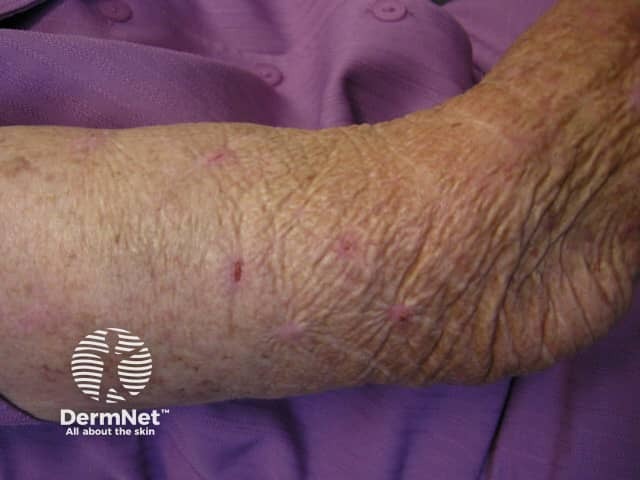
Scratched prurigo
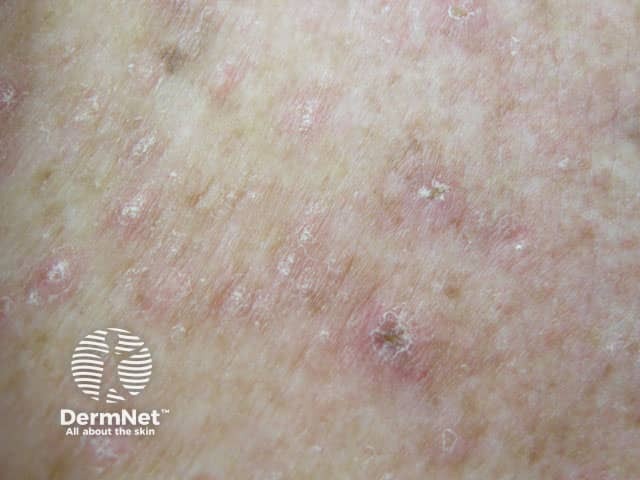
Scaly prurigo
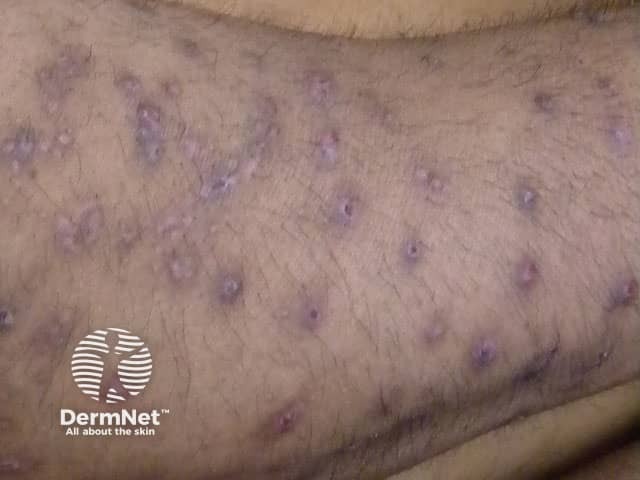
Pigmented prurigo
Prurigo simplex
Prurigo simplex presents as symmetrically distributed, small, intensely itchy, dome-shaped bumps. Sometimes there are tiny blisters. They are most numerous on the outer aspects of the limbs and buttocks, but may occur anywhere on head and neck, trunk and limbs. Prurigo may affect children and adults.
Aternative names for prurigo simplex include chronic prurigo of adults, prurigo mitis, and Hebra prurigo. When the spots are dark in colour, it may be called prurigo pigmentosa.
Often the primary prurigo papule is no longer visible because scratching has removed it. Prurigo may cause considerable distress because severe itch can prevent sleep.
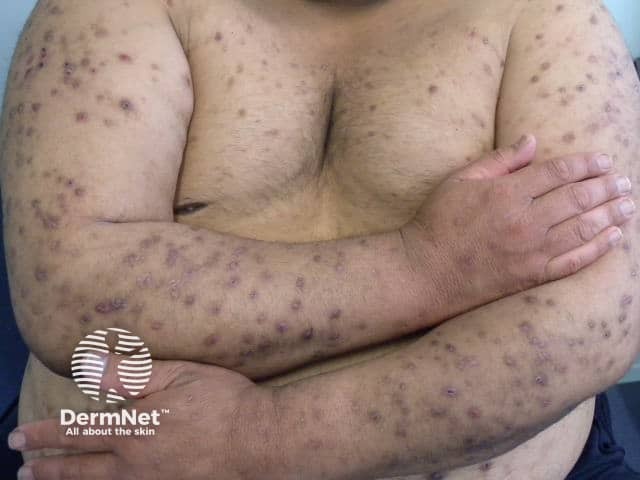
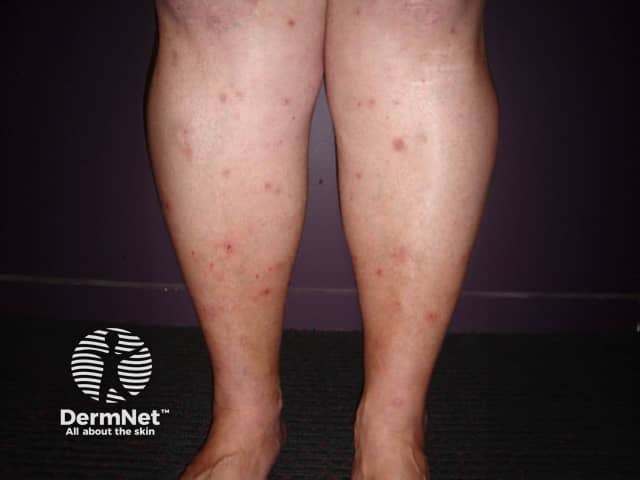

Nodular prurigo
Nodular prurigo presents with hard warty nodules, often showing increased pigmentation. As they are very itchy, they are often ulcerated or crusted. Nodular prurigo is very resistant to treatment.
Prurigo pigmentosa
Prurigo pigmentosa is characterised by an itchy rash with a net-like pigmentation.
Associated conditions
In some people, prurigo is associated with another skin condition or health problem. These include:
- Atopic eczema (Besnier prurigo)
- Bullous pemphigoid (pemphigoid nodularis)
- Discoid (or nummular) eczema (or dermatitis)
- Papular urticaria (an allergic reaction to insect bites)
- Iron deficiency
- Thyroid disease
- Infection with human immunodeficiency virus (HIV) (pruritic papular eruption of HIV)
- Pregnancy
- Chronic renal failure
- Diabetes
- Polycythaemia rubra vera
- Hodgkin lymphoma or non-Hodgkin lymphoma
- Drug abuse, particularly of amphetamines and cocaine
- Spinal nerve damage
Treatment of prurigo
Treatment may include the following diverse agents.
- Topical corticosteroids
- Antihistamines, particularly sedative agents to relieve itch
- Intralesional corticosteroids
- Systemic corticosteroids
- Oral antibiotics, particularly prolonged courses of a tetracycline
- Dapsone
- Phototherapy
More severe disease may be treated with immune suppressive agents.
Severe itch may be relieved by centrally acting medicines. These include:
- Tricyclic antidepressants such as amitriptyline
- Anticonvulsants such as gabapentin, pregabalin or sodium valproate
- Opiate antagonists such as naltrexone.
What investigations should be done?
As there are several skin conditions that present with prurigo, investigations may be necessary to make the diagnosis.
Skin biopsy is often performed to look for specific features of dermatitis herpetiformis, which are diagnostic of that condition. Direct immunofluorescence is also diagnostic for dermatitis herpetiformis. The histology of other forms of prurigo may be nonspecific, or show hyperkeratosis (scale), acanthosis (skin thickening) and inflammatory infiltrate (lymphocytes in the dermis).
Blood tests may include general health screening and indirect immunofluorescence tests.
- Blood count
- Renal function
- Liver function
- Immunoglobulins
- Protein electrophoresis
- Skin antibodies
- Thyroid function tests
Chest X-ray, CT scan or MRI may also be ordered. Further tests will depend on the results of initial screens.
Other types of prurigo
Itchy prurigo papules may arise in several other skin disorders.
- Scabies or body lice infestation
- Arthropod bites due to mosquitoes, sandflies, bedbugs and fleas
- Actinic prurigo (also called Hutchinson prurigo) – prurigo in sun-exposed areas as a form of photosensitivity
- Prurigo of pregnancy
- Dermatitis herpetiformis – an immunobullous disease
- Acne urticata
- Reactive perforating collagenosis
- Folliculitis
- Compulsive skin picking
- Psychoses, in which patients experience formication (sensations of biting and crawling) or delusions of parasitosis
On DermNet
Other websites
- Prurigo Nodularis — Medscape Drugs & Diseases
- Steroid impregnated tape — YouTube: demonstrating tape application
